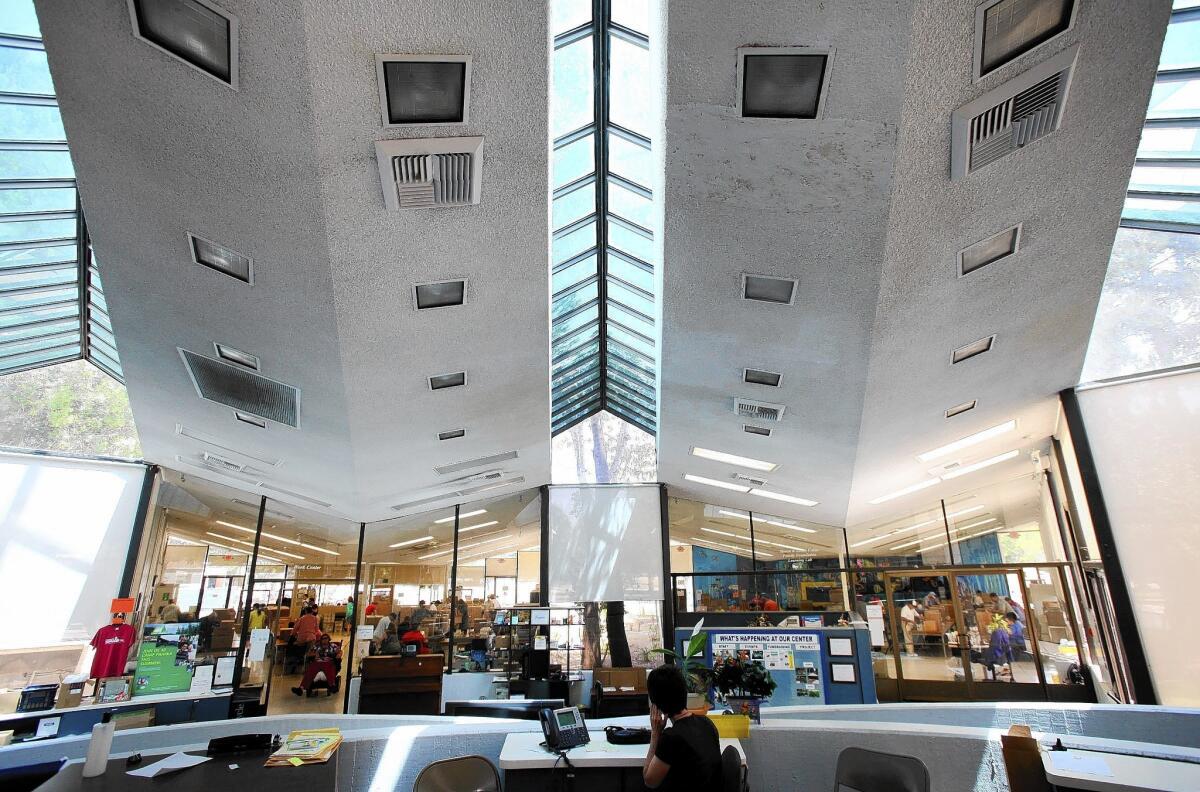L.A. Conservancy seeks to save John Lautner building

In its day, the airy building on Winnetka Avenue was as practical as it was spectacular.
Designed by modernist architect John Lautner, the building has a pie-shaped floor plan that allowed the director of the Crippled Children’s Society facility to sit on an elevated platform and monitor meeting rooms, recreation areas and the outdoors campus.
Now the building is marked for demolition to make room for a treatment facility for senior citizens, its Space Age architecture not considered practical for the job.
But preservationists are not about to let the work of the prominent Googie architect to be knocked down without a fight.
The unique Woodland Hills structure is on a three-acre parcel now owned by AbilityFirst, a nonprofit group that offers job training and placement for disabled adults.
Lautner designed the Rancho del Valle rehabilitation center in 1979. The organization was renamed AbilityFirst 10 years ago and closed its children’s program in 2009 because of a decline in enrollment. The floor plan was drawn to suit the requirements of its director, Mary-Jane Moore.
AbilityFirst officials put the property on the market after deciding to look for space better suited for the adult training that the organization now offers.
Santa Rosa-based Oakmont Senior Living, which has built 40 assisted living developments for senior citizens and is interested in constructing a residential center in Los Angeles, offered to acquire the Winnetka Avenue site.
The firm is proposing to demolish the 11,200-square-foot Lautner building and replace it with a two-story, 84,978-square-foot facility better suited for eldercare.
News that a Lautner-designed structure might fall to the wrecking ball sent preservationists with the Los Angeles Conservancy rushing to a zoning administrator’s hearing to protest. They argued that the potential loss of a historically significant building should be the subject of a full-fledged impact report.
“We would have hoped that the building would be identified and treated as an historic resource,” said Adrian Scott Fine, the conservancy’s advocacy director. “We hope there’s a way for it to be saved, to incorporate the Lautner building into the senior center.”
For the moment, the project is in limbo while the city weighs whether to order that a fuller environmental impact report be prepared.
Lautner is primarily known for fanciful residential designs such as the flying saucer-shaped Chemosphere house in Studio City. Fine described the Winnetka Avenue structure as “a rare institutional project” by the famed architect.
David Saeta, a realty executive and member of AbilityFirst’s board of directors, said the organization picked Oakmont Senior Living after deciding that the firm was “the best and most qualified group” to redevelop the property.
Because of its unique design, the Lautner building is costly to maintain and “functionally obsolete for the needs of our program,” Saeta said.
Keri Castaneda, AbilityFirst’s chief program officer, said her group intends to select a new location to train adults with developmental issues within about a five-mile radius of the current location.
Meanwhile, Oakmont officials said that their Woodland Hills development plans have been put on hold.
“We’re just trying to figure out what’s going on,” said Ken Kidd, the firm’s executive in charge of site acquisition and development.
“We’ve just stopped everything. We can’t do anything at this point. I don’t know what direction this will go,” he said.
Twitter: BobsLAtimes
More to Read
Sign up for Essential California
The most important California stories and recommendations in your inbox every morning.
You may occasionally receive promotional content from the Los Angeles Times.











